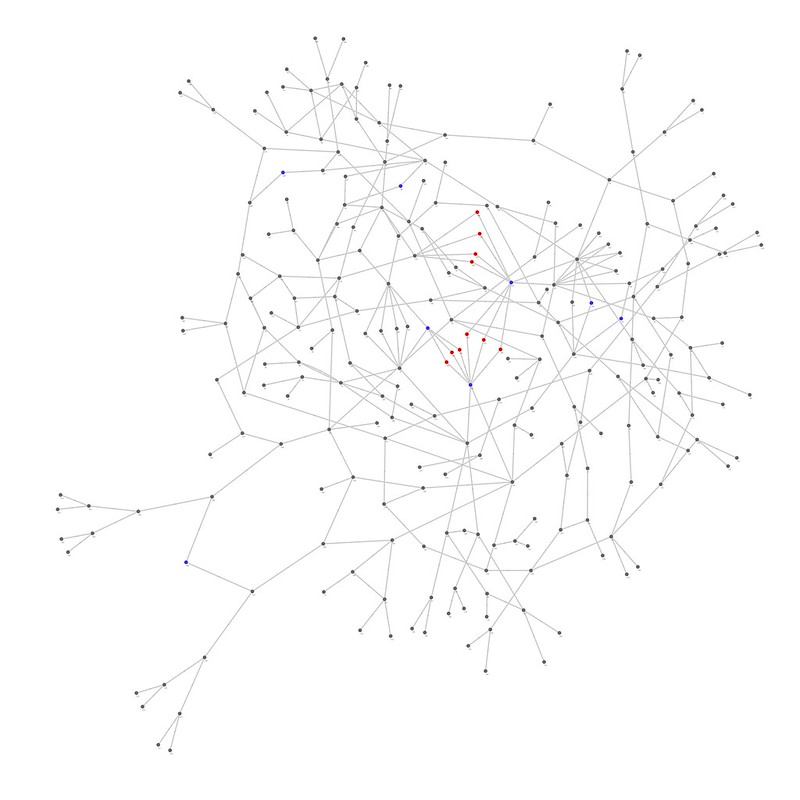A visual representation of the KKA Kai Ken population (so far)
I've been working on mapping the Kai Ken Aigokai (Kai Ken) population. All I have is what is in the registry that I have built based on our imports plus some other dogs that I've gotten info on. I want a visual way to look at the entire population to help us find potential bottlenecks. This will help all of us better understand just how close the population is and what lines to avoid due to these bottlenecks.
Here is my first go at it... I still need to clean it up some. The blue dots are Kai Ken we have in our kennel, the red dots represent Kai we have produced.

Click here to view the full resolution version.
As you can see, even with all the work we have done to import Kai in groups that are as unrelated to the last import group as possible, there is still a very close relation between all of them.
----
Here is my first go at it... I still need to clean it up some. The blue dots are Kai Ken we have in our kennel, the red dots represent Kai we have produced.

Click here to view the full resolution version.
As you can see, even with all the work we have done to import Kai in groups that are as unrelated to the last import group as possible, there is still a very close relation between all of them.
----


Comments
No, this doesn't include Ayu's litter.
I plan to make a version that shows only the KKA Kai in North America, which wouldn't include any of the ancestors that are not directly related to all the dogs already here (this would show how closely related all the KKA imports are to each other).
----
I have a database of about 17 000 entries, and I wonder how the result would look.
Edit: Nevermind, Brad answered. Thanks.
Click here to view the full resolution version.
----
Bah apparently I can't tag Sean.
(in the 1st one. the second one is a ball of string)
art brain checks in!
We have a book upstairs: "Visual Representation of Quantitative Analysis" (I think) all about these kinds of graphs and webs and so forth and various ways to show data visually. Check out Edward Tufte if this sort of thing rocks your boat.
Just wondering because littermates aren't exactly the same distance between their parents.
@ayk - Yes, it's 3D... and I moved some of the litter mates so we could better see them since in the graph they were next to each other on the z-axis. The app doesn't have a great way to out put a 3D file that would be usable on the web.
----
This is all very much a work in progress, but I thought some of you might enjoy seeing it.
Here is a positive side effect of doing this that I had not considered. Reviewing the graph I noticed this, which seemed pretty odd (nodes 66 & 72)...
So I looked it up. Ah, yea, Kai Kokuou #32135 produced his sire (link).... huh??? Opps! I guess I messed up entering someone's pedigree...
So, it's already helped me find a mistake in the DB.
----
@lindsayt - Yes, that is the hope. It will be more revealing as we get more data (more Kai)... We will start to see popular studs and other types of bottle necks.
I'll make a new map to point out some of the current potential bottle necks I'm concerned with. I'll post it later.
----
@tjbart17 - I am a Kai geek, huh? lol
@CarabooA - Nami and Kitora aren't in the DB yet as I am waiting on clarification of #26 in their pedigree. I need that Kai's reg # before I enter them (so I don't end up with duplicates in the DB).
----
More seriously, I'm getting that the blue middle dot must be Yamabushi kennels? And then the other dots are other Kai Ken and their relation to other dogs? Am I right on that? So in that way it is working like a different sort of family tree type representation, with location included?
And the second one, the circular one, is too mysterious for me to even guess at.
@brada1878--this is way cool, thanks for taking the time to put this together, it is quite educational for all of us. I was actually planning to put something like this together for all the shikoku eventually but THESIS comes first!!!
So, if you want to see who is who you can use the reg app by replacing "[id]" with one of the number in the graph of this URL: http://www.yamabushikennel.org/apps/pedigree/index.php?r=dog/view&id=[id]
For example, here is Hana's (id 330), URL: http://www.yamabushikennel.org/apps/pedigree/index.php?r=dog/view&id=330
----